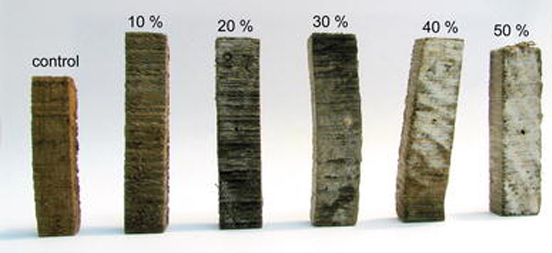We showed that the PEG penetrates inside the fibers and interacts at a molecular level with the cellulose fibrils thus restoring the dynamics properties of the damaged molecular cell wall network. At high PEG concentration, the polymer accumulates in the remaining free volume with looser molecular interactions with the residual wood components. This feature explains the facility for the PEG to exude from the wood and led to deleterious consequences for the restored artefacts.
In archaeology, the excavation and treatment of waterlogged wooden objects is a challenge for the scientists in charge of their conservation since they appear severely degraded. The most widespread methods are based on polyethylene glycol (PEG) impregnation since they are easy to handle even on very large objects such as shipwrecks. PEG toxicity and environment concerns are easy to control, even outside a laboratory context. It is one of the favourite treatments of the conservators because of its reversible feature. Extensive studies have been performed to optimize the conservation process by taking into account features of different woods, which can drastically differ from one sample to another. The degradation state of the wood, the sample size, and the presence of metallic impurities are the most studied. However, little effort has been made to study the interactions of PEG with the residual cell wall components at a molecular level. This aspect is fundamental to understanding and optimizing the impregnation process for long term preservation of conserved objects. Non optimized conditions of conservation treatments are probably at the origin of deleterious behaviours, such as PEG exudations and material cracks, of the treated wooden objects that can appear during aging of such materials even in the controlled environment of a museum.
Through the NMR measurements of different relaxation times and dynamic exchange rates one can get insights in molecular motions. In high-resolution solid-state NMR, the relevant probes are mainly the cross-polarization time constants, TCH, the proton spin-lattice relaxation time constants in the rotating frame, T1ρH. In particular T1ρH allows the characterization of a network of protons. When all T1ρH values are similar, a unique proton spin bath may be considered and the material is homogeneous at a nanometric scale. On the other hand, the presence of different T1ρH values strongly supports the conclusion that the material is made of several molecular domains and cannot be considered as a molecular blend. Therefore T1ρH allows to separate, for a given polymeric material, a molecular blend from a mechanical mixture.
We have showed that the PEG enters the fibrils and develops a molecular blend due to strong molecular interactions with the cellulose molecules comparable with those between hemicelluloses in the fresh wood. However by increasing the amount of PEG inside the wood, the polymer accumulates in remaining free volumes within the wood fibres, which explains the deleterious behaviours that can appear during the aging of conserved materials. Such a study is valuable to understand and optimize the impregnation process for long term preservation of archaeological objects. This work is the result of collaboration with ARC-Nucleart laboratory that has been started for more than ten years.

Morphological aspects of archaeological woods impregnated by PEG 4000 solutions of increasing concentrations (wt% of PEG: water, w:w). The strong white exudations that appear at the surface of wood at PEG concentrations above 10% illustrate the presence of non-interacting PEG inside the wood.